Dhruv Mahajan
Jack
A Systematic Examination of Preference Learning through the Lens of Instruction-Following
Dec 18, 2024Abstract:Preference learning is a widely adopted post-training technique that aligns large language models (LLMs) to human preferences and improves specific downstream task capabilities. In this work we systematically investigate how specific attributes of preference datasets affect the alignment and downstream performance of LLMs in instruction-following tasks. We use a novel synthetic data generation pipeline to generate 48,000 unique instruction-following prompts with combinations of 23 verifiable constraints that enable fine-grained and automated quality assessments of model responses. With our synthetic prompts, we use two preference dataset curation methods - rejection sampling (RS) and Monte Carlo Tree Search (MCTS) - to obtain pairs of (chosen, rejected) responses. Then, we perform experiments investigating the effects of (1) the presence of shared prefixes between the chosen and rejected responses, (2) the contrast and quality of the chosen, rejected responses and (3) the complexity of the training prompts. Our experiments reveal that shared prefixes in preference pairs, as generated by MCTS, provide marginal but consistent improvements and greater stability across challenging training configurations. High-contrast preference pairs generally outperform low-contrast pairs; however, combining both often yields the best performance by balancing diversity and learning efficiency. Additionally, training on prompts of moderate difficulty leads to better generalization across tasks, even for more complex evaluation scenarios, compared to overly challenging prompts. Our findings provide actionable insights into optimizing preference data curation for instruction-following tasks, offering a scalable and effective framework for enhancing LLM training and alignment.
Self-Generated Critiques Boost Reward Modeling for Language Models
Nov 25, 2024



Abstract:Reward modeling is crucial for aligning large language models (LLMs) with human preferences, especially in reinforcement learning from human feedback (RLHF). However, current reward models mainly produce scalar scores and struggle to incorporate critiques in a natural language format. We hypothesize that predicting both critiques and the scalar reward would improve reward modeling ability. Motivated by this, we propose Critic-RM, a framework that improves reward models using self-generated critiques without extra supervision. Critic-RM employs a two-stage process: generating and filtering high-quality critiques, followed by joint fine-tuning on reward prediction and critique generation. Experiments across benchmarks show that Critic-RM improves reward modeling accuracy by 3.7%-7.3% compared to standard reward models and LLM judges, demonstrating strong performance and data efficiency. Additional studies further validate the effectiveness of generated critiques in rectifying flawed reasoning steps with 2.5%-3.2% gains in improving reasoning accuracy.
Law of the Weakest Link: Cross Capabilities of Large Language Models
Sep 30, 2024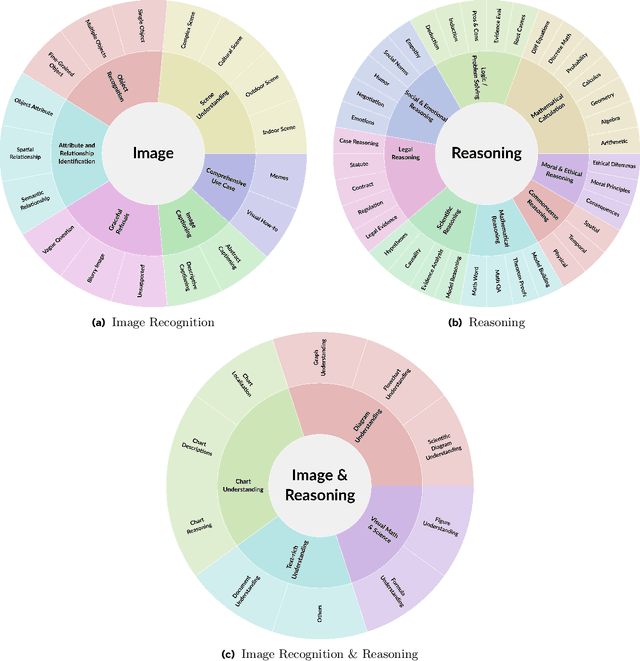
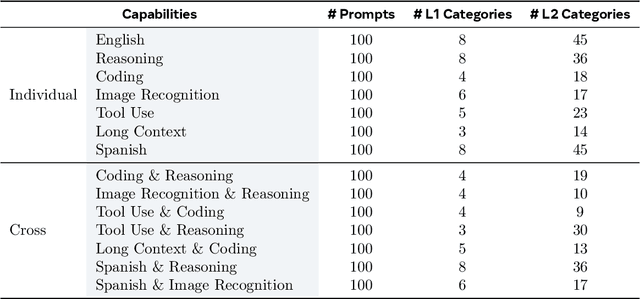
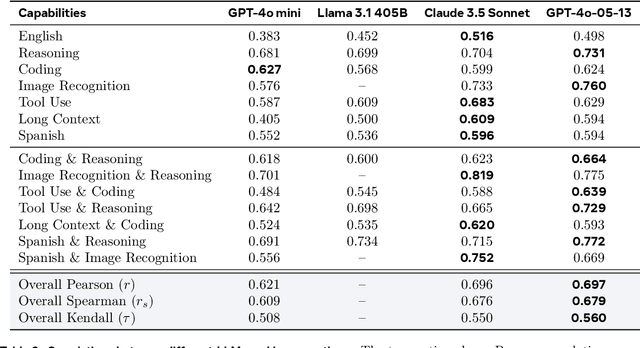
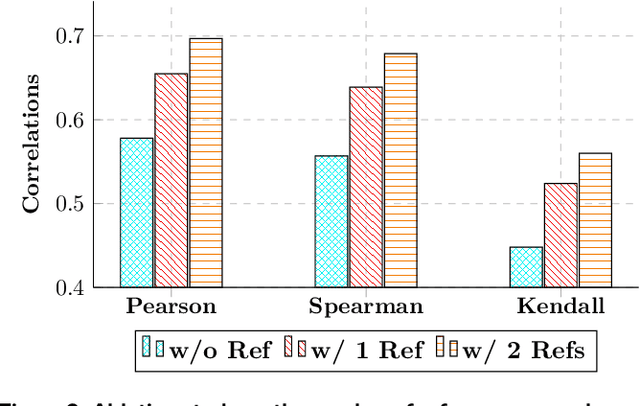
Abstract:The development and evaluation of Large Language Models (LLMs) have largely focused on individual capabilities. However, this overlooks the intersection of multiple abilities across different types of expertise that are often required for real-world tasks, which we term cross capabilities. To systematically explore this concept, we first define seven core individual capabilities and then pair them to form seven common cross capabilities, each supported by a manually constructed taxonomy. Building on these definitions, we introduce CrossEval, a benchmark comprising 1,400 human-annotated prompts, with 100 prompts for each individual and cross capability. To ensure reliable evaluation, we involve expert annotators to assess 4,200 model responses, gathering 8,400 human ratings with detailed explanations to serve as reference examples. Our findings reveal that, in both static evaluations and attempts to enhance specific abilities, current LLMs consistently exhibit the "Law of the Weakest Link," where cross-capability performance is significantly constrained by the weakest component. Specifically, across 58 cross-capability scores from 17 models, 38 scores are lower than all individual capabilities, while 20 fall between strong and weak, but closer to the weaker ability. These results highlight the under-performance of LLMs in cross-capability tasks, making the identification and improvement of the weakest capabilities a critical priority for future research to optimize performance in complex, multi-dimensional scenarios.
The Llama 3 Herd of Models
Jul 31, 2024Abstract:Modern artificial intelligence (AI) systems are powered by foundation models. This paper presents a new set of foundation models, called Llama 3. It is a herd of language models that natively support multilinguality, coding, reasoning, and tool usage. Our largest model is a dense Transformer with 405B parameters and a context window of up to 128K tokens. This paper presents an extensive empirical evaluation of Llama 3. We find that Llama 3 delivers comparable quality to leading language models such as GPT-4 on a plethora of tasks. We publicly release Llama 3, including pre-trained and post-trained versions of the 405B parameter language model and our Llama Guard 3 model for input and output safety. The paper also presents the results of experiments in which we integrate image, video, and speech capabilities into Llama 3 via a compositional approach. We observe this approach performs competitively with the state-of-the-art on image, video, and speech recognition tasks. The resulting models are not yet being broadly released as they are still under development.
Context Diffusion: In-Context Aware Image Generation
Dec 06, 2023Abstract:We propose Context Diffusion, a diffusion-based framework that enables image generation models to learn from visual examples presented in context. Recent work tackles such in-context learning for image generation, where a query image is provided alongside context examples and text prompts. However, the quality and fidelity of the generated images deteriorate when the prompt is not present, demonstrating that these models are unable to truly learn from the visual context. To address this, we propose a novel framework that separates the encoding of the visual context and preserving the structure of the query images. This results in the ability to learn from the visual context and text prompts, but also from either one of them. Furthermore, we enable our model to handle few-shot settings, to effectively address diverse in-context learning scenarios. Our experiments and user study demonstrate that Context Diffusion excels in both in-domain and out-of-domain tasks, resulting in an overall enhancement in image quality and fidelity compared to counterpart models.
Text-to-Sticker: Style Tailoring Latent Diffusion Models for Human Expression
Nov 17, 2023



Abstract:We introduce Style Tailoring, a recipe to finetune Latent Diffusion Models (LDMs) in a distinct domain with high visual quality, prompt alignment and scene diversity. We choose sticker image generation as the target domain, as the images significantly differ from photorealistic samples typically generated by large-scale LDMs. We start with a competent text-to-image model, like Emu, and show that relying on prompt engineering with a photorealistic model to generate stickers leads to poor prompt alignment and scene diversity. To overcome these drawbacks, we first finetune Emu on millions of sticker-like images collected using weak supervision to elicit diversity. Next, we curate human-in-the-loop (HITL) Alignment and Style datasets from model generations, and finetune to improve prompt alignment and style alignment respectively. Sequential finetuning on these datasets poses a tradeoff between better style alignment and prompt alignment gains. To address this tradeoff, we propose a novel fine-tuning method called Style Tailoring, which jointly fits the content and style distribution and achieves best tradeoff. Evaluation results show our method improves visual quality by 14%, prompt alignment by 16.2% and scene diversity by 15.3%, compared to prompt engineering the base Emu model for stickers generation.
Emu: Enhancing Image Generation Models Using Photogenic Needles in a Haystack
Sep 27, 2023



Abstract:Training text-to-image models with web scale image-text pairs enables the generation of a wide range of visual concepts from text. However, these pre-trained models often face challenges when it comes to generating highly aesthetic images. This creates the need for aesthetic alignment post pre-training. In this paper, we propose quality-tuning to effectively guide a pre-trained model to exclusively generate highly visually appealing images, while maintaining generality across visual concepts. Our key insight is that supervised fine-tuning with a set of surprisingly small but extremely visually appealing images can significantly improve the generation quality. We pre-train a latent diffusion model on $1.1$ billion image-text pairs and fine-tune it with only a few thousand carefully selected high-quality images. The resulting model, Emu, achieves a win rate of $82.9\%$ compared with its pre-trained only counterpart. Compared to the state-of-the-art SDXLv1.0, Emu is preferred $68.4\%$ and $71.3\%$ of the time on visual appeal on the standard PartiPrompts and our Open User Input benchmark based on the real-world usage of text-to-image models. In addition, we show that quality-tuning is a generic approach that is also effective for other architectures, including pixel diffusion and masked generative transformer models.
Filtering, Distillation, and Hard Negatives for Vision-Language Pre-Training
Jan 05, 2023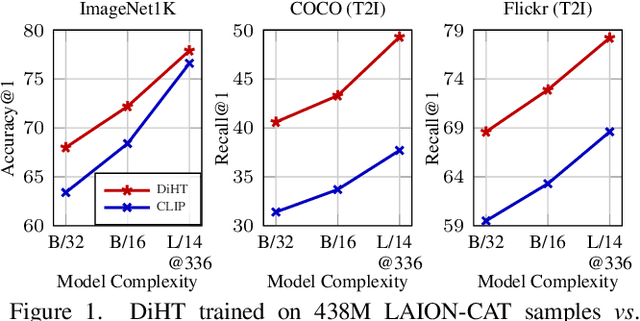
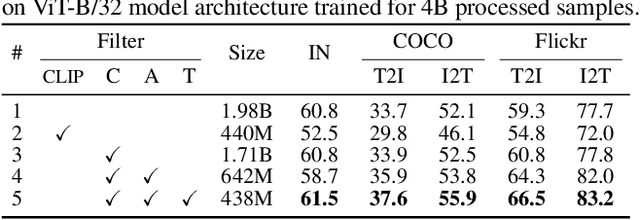
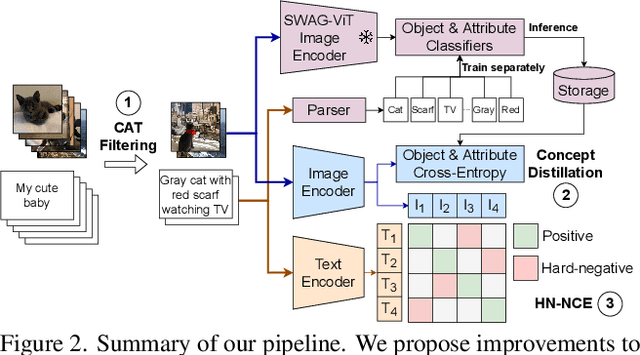
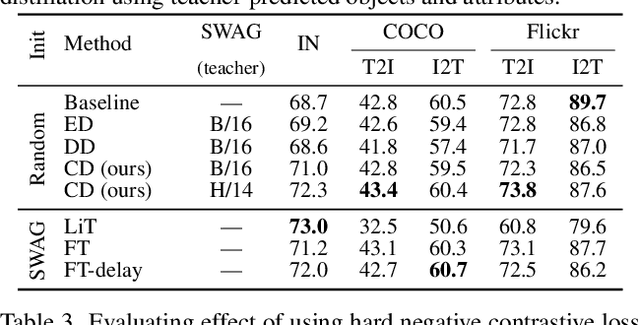
Abstract:Vision-language models trained with contrastive learning on large-scale noisy data are becoming increasingly popular for zero-shot recognition problems. In this paper we improve the following three aspects of the contrastive pre-training pipeline: dataset noise, model initialization and the training objective. First, we propose a straightforward filtering strategy titled Complexity, Action, and Text-spotting (CAT) that significantly reduces dataset size, while achieving improved performance across zero-shot vision-language tasks. Next, we propose an approach titled Concept Distillation to leverage strong unimodal representations for contrastive training that does not increase training complexity while outperforming prior work. Finally, we modify the traditional contrastive alignment objective, and propose an importance-sampling approach to up-sample the importance of hard-negatives without adding additional complexity. On an extensive zero-shot benchmark of 29 tasks, our Distilled and Hard-negative Training (DiHT) approach improves on 20 tasks compared to the baseline. Furthermore, for few-shot linear probing, we propose a novel approach that bridges the gap between zero-shot and few-shot performance, substantially improving over prior work. Models are available at https://github.com/facebookresearch/diht.
PACO: Parts and Attributes of Common Objects
Jan 04, 2023
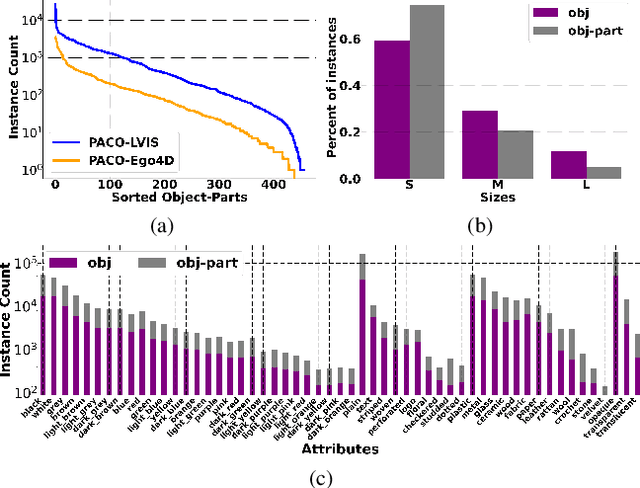
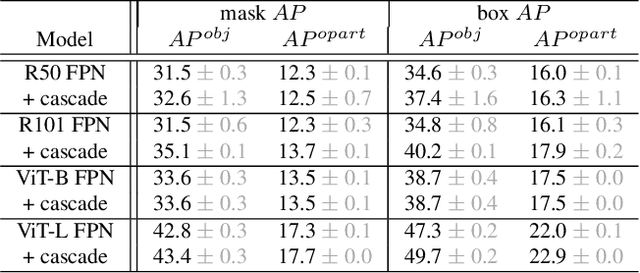

Abstract:Object models are gradually progressing from predicting just category labels to providing detailed descriptions of object instances. This motivates the need for large datasets which go beyond traditional object masks and provide richer annotations such as part masks and attributes. Hence, we introduce PACO: Parts and Attributes of Common Objects. It spans 75 object categories, 456 object-part categories and 55 attributes across image (LVIS) and video (Ego4D) datasets. We provide 641K part masks annotated across 260K object boxes, with roughly half of them exhaustively annotated with attributes as well. We design evaluation metrics and provide benchmark results for three tasks on the dataset: part mask segmentation, object and part attribute prediction and zero-shot instance detection. Dataset, models, and code are open-sourced at https://github.com/facebookresearch/paco.
Scalable Interpretability via Polynomials
Jun 08, 2022



Abstract:Generalized Additive Models (GAMs) have quickly become the leading choice for fully-interpretable machine learning. However, unlike uninterpretable methods such as DNNs, they lack expressive power and easy scalability, and are hence not a feasible alternative for real-world tasks. We present a new class of GAMs that use tensor rank decompositions of polynomials to learn powerful, {\em fully-interpretable} models. Our approach, titled Scalable Polynomial Additive Models (SPAM) is effortlessly scalable and models {\em all} higher-order feature interactions without a combinatorial parameter explosion. SPAM outperforms all current interpretable approaches, and matches DNN/XGBoost performance on a series of real-world benchmarks with up to hundreds of thousands of features. We demonstrate by human subject evaluations that SPAMs are demonstrably more interpretable in practice, and are hence an effortless replacement for DNNs for creating interpretable and high-performance systems suitable for large-scale machine learning. Source code is available at https://github.com/facebookresearch/nbm-spam.
 Add to Chrome
Add to Chrome Add to Firefox
Add to Firefox Add to Edge
Add to Edge